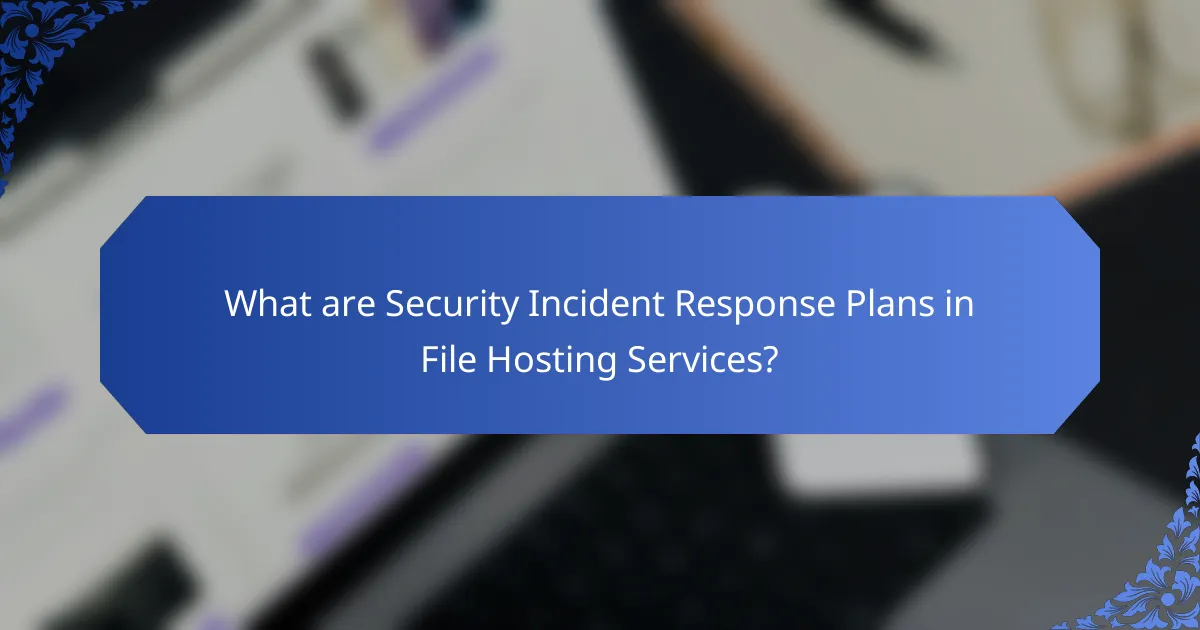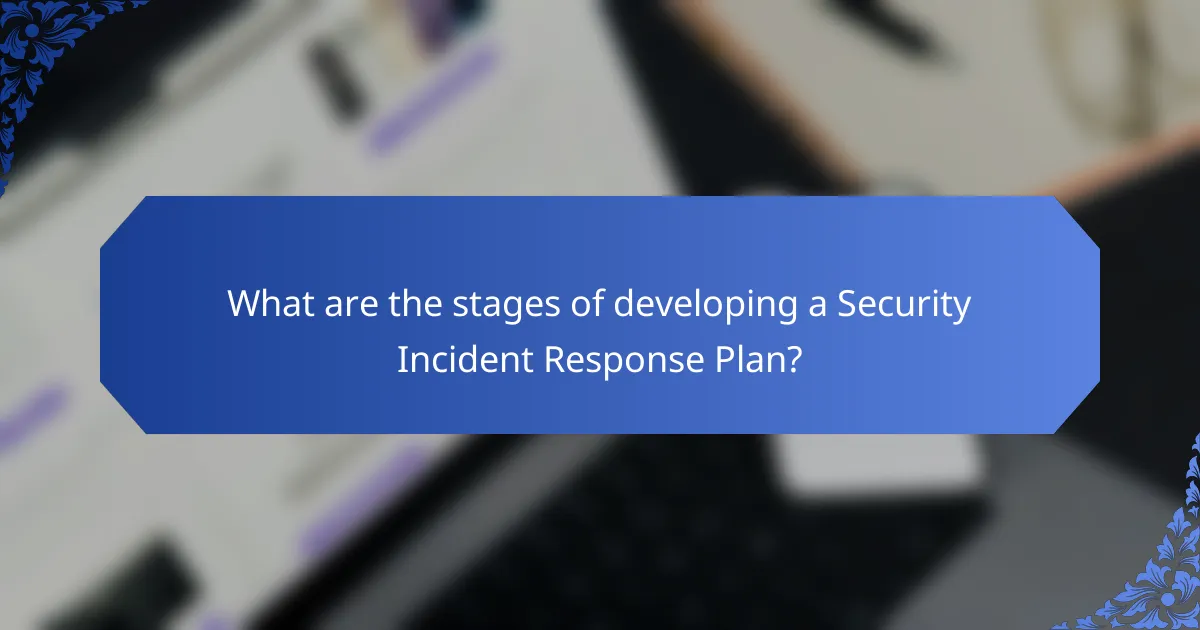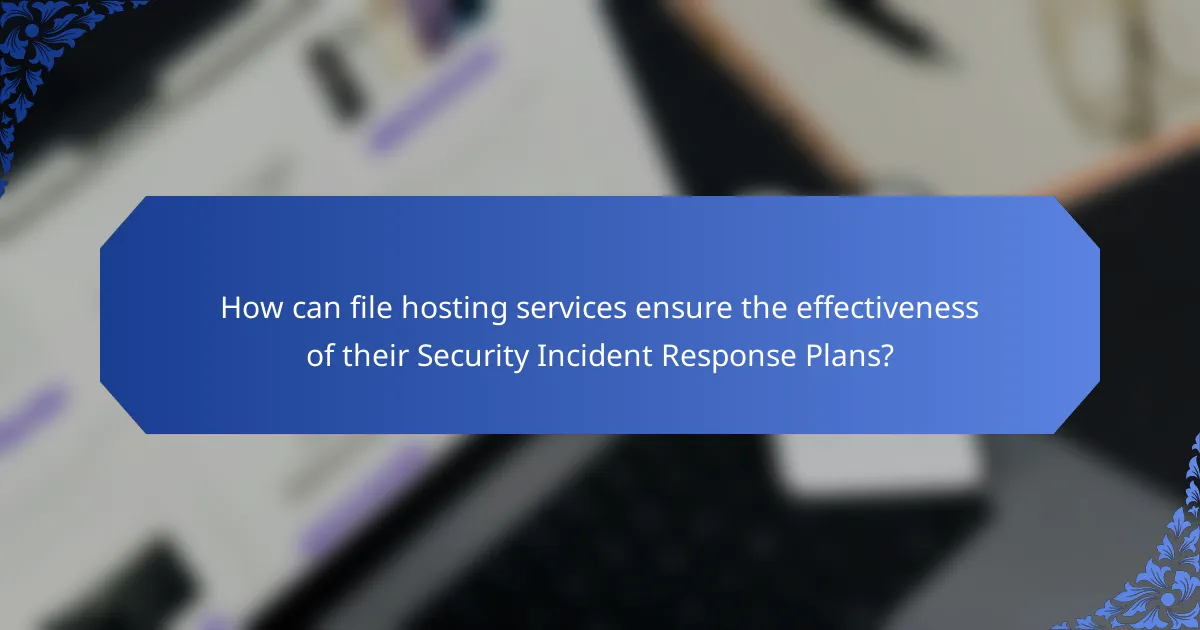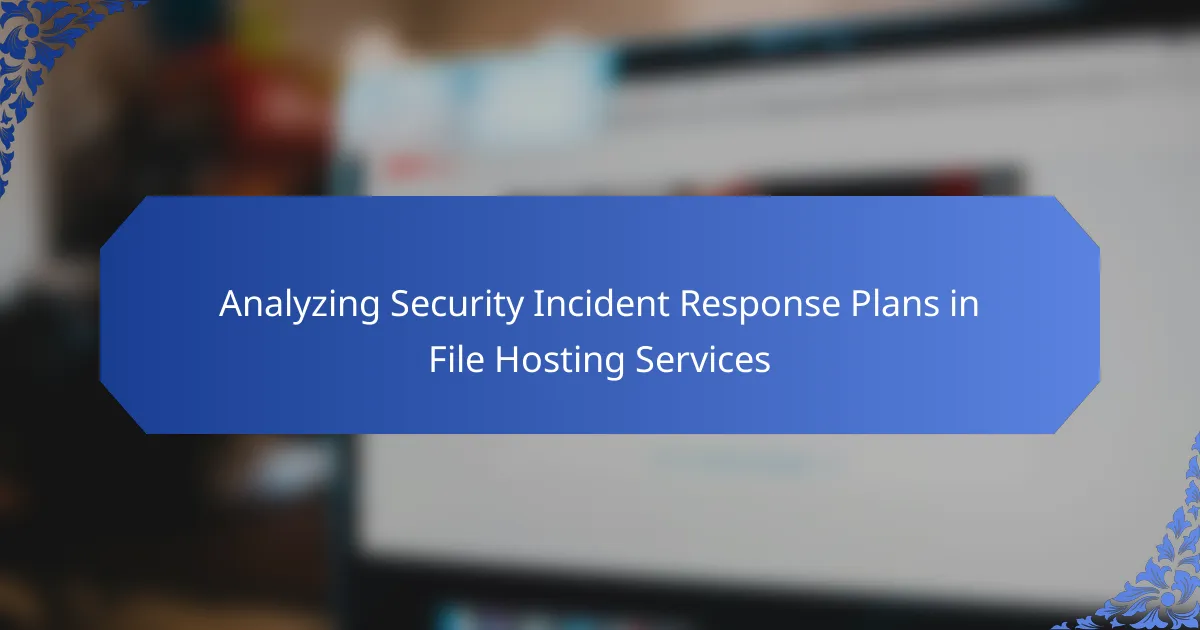Security Incident Response Plans (SIRPs) in file hosting services are essential structured procedures designed to address security breaches. These plans encompass phases such as identification, containment, eradication, recovery, and lessons learned, ensuring a comprehensive approach to mitigating damage. Effective SIRPs are informed by risk assessments and compliance requirements, which help organizations minimize data loss and service disruptions. Regular updates and testing of these plans enhance their effectiveness, aligning with industry standards like NIST SP 800-61. The article analyzes the critical stages of developing SIRPs and emphasizes best practices for continuous improvement, ultimately highlighting the financial benefits of having formal incident response strategies in place.

What are Security Incident Response Plans in File Hosting Services?
Security Incident Response Plans in file hosting services are structured procedures for addressing security breaches. These plans outline roles, responsibilities, and actions necessary to mitigate damage. They include identification, containment, eradication, recovery, and lessons learned phases. Effective plans are based on risk assessments and compliance requirements. They ensure rapid response to incidents, minimizing data loss and service disruption. Regular testing and updates to these plans enhance their effectiveness. According to the Ponemon Institute, organizations with formal incident response plans can reduce the cost of a data breach by an average of $1.23 million.
How do Security Incident Response Plans function in file hosting environments?
Security Incident Response Plans (SIRPs) in file hosting environments function by providing a structured approach to identify, manage, and mitigate security incidents. These plans outline procedures for detecting potential threats to data integrity and availability. They establish roles and responsibilities for the incident response team. SIRPs include steps for containment, eradication, and recovery from incidents. They also emphasize communication strategies for informing stakeholders about incidents. Regular training and testing of the SIRP ensure the team is prepared for real incidents. Compliance with regulatory requirements is a key aspect of these plans. Effective SIRPs can significantly reduce the impact of security breaches on file hosting services.
What are the key components of an effective Security Incident Response Plan?
An effective Security Incident Response Plan includes several key components. First, it should have a clear definition of roles and responsibilities. This ensures that everyone knows their tasks during an incident. Next, the plan must outline communication protocols. Effective communication minimizes confusion and speeds up response times.
Another essential component is detection and analysis procedures. These procedures help identify incidents quickly and assess their impact. The plan should also include containment strategies. Containment prevents further damage during an ongoing incident.
Additionally, the plan must detail eradication and recovery steps. These steps guide the organization in removing threats and restoring systems. Finally, the plan should incorporate a review and improvement process. This process allows for learning from incidents and enhancing future responses.
Research shows that organizations with comprehensive incident response plans can reduce recovery time by up to 50%. This statistic highlights the importance of having a well-structured plan.
How do these components interact during a security incident?
During a security incident, various components such as detection, analysis, containment, eradication, and recovery interact in a defined sequence. Detection involves identifying the security breach through monitoring systems. Once detected, analysis assesses the nature and scope of the incident. This is followed by containment, where immediate measures are taken to prevent further damage. After containment, eradication focuses on removing the root cause of the incident. Finally, recovery restores affected systems and services to normal operation. Each of these components is interconnected; for instance, effective detection relies on robust monitoring systems, while analysis informs containment strategies. The success of the incident response hinges on the seamless integration and communication among these components.
Why are Security Incident Response Plans critical for file hosting services?
Security Incident Response Plans are critical for file hosting services because they ensure rapid and effective management of security breaches. These plans outline procedures for identifying, responding to, and recovering from incidents that threaten data integrity and availability. They help minimize damage during security events, reducing potential financial losses and reputational harm. According to a report by IBM, the average cost of a data breach is $4.24 million, highlighting the financial impact of inadequate response strategies. Furthermore, having a structured response plan enhances compliance with regulations such as GDPR and HIPAA, which require organizations to protect sensitive data. In summary, Security Incident Response Plans are essential for safeguarding data and maintaining operational resilience in file hosting services.
What risks do file hosting services face without a proper response plan?
File hosting services face significant risks without a proper response plan. These risks include data breaches, which can lead to unauthorized access to sensitive information. Without a response plan, the recovery time from such incidents can be prolonged. This can result in financial losses due to downtime and loss of user trust. Additionally, regulatory penalties may occur if data protection laws are violated. The lack of a response plan can also hinder effective communication during a crisis. This can lead to misinformation spreading among users. Furthermore, without a structured approach, the service may struggle to identify the root cause of incidents. This can result in repeated security failures. Overall, the absence of a proper response plan exposes file hosting services to multiple vulnerabilities.
How do these plans mitigate potential damages from security incidents?
Security incident response plans mitigate potential damages by providing structured protocols for addressing security breaches. These plans outline specific roles and responsibilities for team members during an incident. They include predefined steps for identifying, containing, and eradicating threats. Effective communication strategies are established to ensure timely information sharing. Regular training and simulations prepare staff for real incidents, enhancing their response capabilities. Additionally, post-incident analysis helps identify weaknesses and improve future responses. Research indicates that organizations with formal incident response plans experience 50% less damage from security breaches compared to those without such plans.

What are the stages of developing a Security Incident Response Plan?
The stages of developing a Security Incident Response Plan include preparation, detection, analysis, containment, eradication, recovery, and lessons learned. Preparation involves establishing policies and procedures, training staff, and ensuring resources are available. Detection focuses on identifying potential security incidents through monitoring and alerts. Analysis involves assessing the incident’s nature and impact to understand its implications. Containment aims to limit the damage and prevent further escalation. Eradication is the process of removing the cause of the incident from the environment. Recovery focuses on restoring systems and services to normal operations. Finally, lessons learned involve reviewing the incident to improve future response efforts. Each stage is critical for an effective response to security incidents.
How can organizations assess their current security posture?
Organizations can assess their current security posture through comprehensive security assessments. These assessments include vulnerability scans, [censured] testing, and risk assessments. Vulnerability scans identify known weaknesses in systems and applications. [censured] testing simulates attacks to evaluate the effectiveness of security measures. Risk assessments analyze potential threats and their impact on business operations.
Regular audits of security policies and procedures are also essential. These audits ensure compliance with industry standards and regulations. Employee training on security awareness further strengthens the security posture. Monitoring network traffic for anomalies helps detect potential breaches.
According to a 2022 report by Cybersecurity & Infrastructure Security Agency, organizations that conduct regular assessments are 50% more likely to identify security gaps. This data underscores the importance of ongoing evaluation of security measures.
What tools and methodologies are used for security assessments?
Common tools for security assessments include vulnerability scanners, [censured] testing tools, and security information and event management (SIEM) systems. Vulnerability scanners, such as Nessus and Qualys, identify security weaknesses in systems. [censured] testing tools like Metasploit simulate attacks to evaluate defenses. SIEM systems, including Splunk and LogRhythm, analyze security data for real-time threat detection. Methodologies often used are OWASP, NIST, and ISO/IEC standards. OWASP focuses on web application security. NIST provides a comprehensive framework for managing cybersecurity risks. ISO/IEC standards offer guidelines for information security management. These tools and methodologies are essential for identifying, evaluating, and mitigating security risks effectively.
How do assessment results inform the development of the response plan?
Assessment results provide critical insights that shape the response plan. They identify vulnerabilities and strengths within the current security framework. By analyzing these results, organizations can prioritize risks effectively. This prioritization helps in allocating resources where they are most needed. Assessment results also inform the selection of appropriate response strategies. For instance, if a vulnerability is identified as high-risk, a specific mitigation strategy can be developed. Furthermore, these results guide the creation of training programs for staff. This ensures that personnel are prepared to handle identified threats. Overall, assessment results create a data-driven foundation for a robust response plan.
What steps are involved in creating a Security Incident Response Plan?
Creating a Security Incident Response Plan involves several key steps. First, identify the team responsible for incident response. This team should include members from IT, security, and management. Next, assess the organization’s current security posture and potential threats. This assessment helps in understanding vulnerabilities. Then, develop and document the response procedures for various incident types. These procedures should be clear and actionable. After that, establish communication protocols for notifying stakeholders during an incident. This ensures timely updates and coordination. Finally, conduct regular training and simulations to test the plan’s effectiveness. Regular updates to the plan are also essential as threats evolve.
How do organizations establish roles and responsibilities for incident response?
Organizations establish roles and responsibilities for incident response by creating a structured incident response plan. This plan outlines specific roles such as incident commander, technical lead, and communication officer. Each role has defined responsibilities to ensure a coordinated response. Organizations typically conduct a risk assessment to identify potential incidents and their impacts. They then assign roles based on expertise and the nature of the incidents. Training and simulations are conducted to prepare staff for their roles. Regular reviews and updates of the incident response plan ensure its effectiveness. A clear hierarchy and communication channels are established to facilitate swift action during incidents.
What processes should be included for detecting and reporting incidents?
Incident detection processes should include continuous monitoring and analysis of system logs. This involves utilizing automated tools to identify anomalies. Regular vulnerability assessments are essential for proactive incident detection. User behavior analytics can help in recognizing suspicious activities.
For reporting incidents, establish a clear communication protocol. This should outline who to notify and the information required. Timely reporting is crucial to minimize damage. Training staff on incident reporting procedures is also necessary.
These processes align with best practices in cybersecurity frameworks, such as NIST and ISO standards. Effective detection and reporting can significantly reduce incident impact.

How can file hosting services ensure the effectiveness of their Security Incident Response Plans?
File hosting services can ensure the effectiveness of their Security Incident Response Plans by regularly updating and testing these plans. Regular updates incorporate the latest security threats and vulnerabilities. Testing the plans through simulations helps identify gaps and improve response strategies. Training staff on incident response procedures enhances preparedness. Establishing clear communication channels facilitates efficient information sharing during incidents. Conducting post-incident reviews allows for continuous improvement of response strategies. These practices align with industry standards, such as NIST SP 800-61, which emphasizes the importance of preparedness and adaptability in incident response.
What training and resources are necessary for staff involved in incident response?
Staff involved in incident response require specialized training and access to critical resources. Training should include coursework in cybersecurity fundamentals, incident management, and threat detection. Staff must also participate in simulations and tabletop exercises to practice response strategies. Resources necessary for effective incident response include access to security tools, threat intelligence platforms, and communication systems. Additionally, staff should have updated documentation on incident response protocols and legal compliance requirements. These elements ensure staff are prepared to handle incidents effectively and efficiently.
How can ongoing training improve response effectiveness?
Ongoing training enhances response effectiveness by ensuring that personnel remain updated on best practices and emerging threats. Regular training sessions keep skills sharp and reinforce knowledge of protocols. This leads to quicker identification and resolution of security incidents. Studies show that organizations with continuous training programs experience a 50% reduction in response times. Furthermore, ongoing training fosters teamwork and communication among responders. Improved collaboration results in more coordinated and efficient incident management. Ultimately, ongoing training is essential for maintaining a proactive security posture in file hosting services.
What resources are available for enhancing incident response capabilities?
Resources available for enhancing incident response capabilities include training programs, incident response tools, and frameworks. Training programs improve team skills and readiness. Tools like SIEM (Security Information and Event Management) systems facilitate real-time monitoring and analysis. Frameworks such as NIST SP 800-61 provide structured guidance for incident handling. Additionally, threat intelligence services offer insights into emerging threats. Regular tabletop exercises help teams practice responses to simulated incidents. Investing in these resources strengthens overall incident response effectiveness.
What best practices should be followed for maintaining and updating Security Incident Response Plans?
Regularly review and update Security Incident Response Plans (SIRPs) to ensure effectiveness. Conduct biannual assessments to identify gaps and incorporate lessons learned from past incidents. Engage stakeholders in the review process to gather diverse insights. Maintain documentation of all updates to track changes over time. Train personnel on updated procedures to ensure readiness. Test the plans through simulations or tabletop exercises to validate their effectiveness. Monitor regulatory changes and industry standards to align the SIRP accordingly. Incorporate feedback from actual incidents to enhance the plan’s relevance and applicability.
How often should response plans be reviewed and tested?
Response plans should be reviewed and tested at least annually. Regular reviews ensure that the plans remain effective and relevant. Testing the plans helps identify gaps and areas for improvement. Some organizations may choose to conduct reviews more frequently, such as quarterly or biannually. This is especially true after significant incidents or changes in the operational environment. The National Institute of Standards and Technology (NIST) recommends regular testing as part of best practices for incident response. Regular updates and tests enhance preparedness and reduce response times during actual incidents.
What common pitfalls should organizations avoid when updating their plans?
Organizations should avoid several common pitfalls when updating their plans. Firstly, neglecting stakeholder involvement can lead to misalignment with organizational goals. Secondly, failing to incorporate lessons learned from previous incidents may result in repeated mistakes. Thirdly, overlooking the need for regular reviews can cause plans to become outdated. Additionally, not testing the updated plans through simulations can lead to unpreparedness during actual incidents. Lastly, inadequate training for staff on the updated procedures can hinder effective implementation. These pitfalls can significantly impair the effectiveness of security incident response plans in file hosting services.
What practical tips can enhance the Security Incident Response Plans in file hosting services?
Regularly update and test the Security Incident Response Plans (SIRPs) in file hosting services. Frequent updates ensure relevance to evolving threats. Conduct tabletop exercises to simulate incidents and assess response effectiveness. Establish clear communication channels for stakeholders during incidents. Maintain an inventory of critical assets to prioritize protection and response efforts. Implement a centralized logging system for real-time monitoring and analysis of security events. Train staff on incident response protocols to enhance readiness and minimize response times. Review and analyze past incidents to identify weaknesses and improve future responses.
Security Incident Response Plans (SIRPs) in file hosting services are essential structured procedures designed to address security breaches effectively. This article analyzes the key components of SIRPs, including detection, containment, eradication, and recovery, emphasizing their importance in minimizing data loss and service disruption. It also discusses the risks associated with the absence of a response plan and the stages involved in developing an effective SIRP. Additionally, the article highlights best practices for maintaining and updating these plans to enhance organizational resilience against security incidents.
